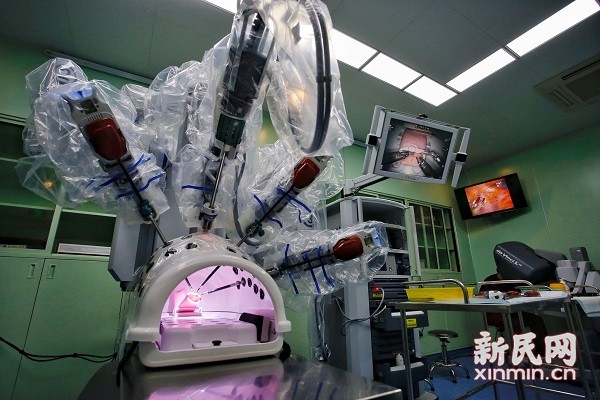


Surgical robots have performed more than 40,000 operations in China by February 2017 since the first one of its kind was introduced to China in 2006, according to Da Vinci Surgical Robot International Training Center, Shanghai-based Changhai Hospital, Xinhuanet.com reported on Sept. 11.
Wang Gongxian, vice director of the First Affiliated Hospital of Nanchang University introduced that the robot arm with the operating forceps can freely rotate 540 degrees, which is more flexible than human arms.
Wang added that the trauma caused in operations performed by surgical robots can be smaller and the treatment can be more precise compared with traditional operations.
Robot arms were designed according to the functions of human hands. They will not tremble even if a doctor’s hands shake, said Ou Yongsheng, a researcher at Shenzhen Institutes of Advanced Technology under Chinese Academy of Sciences.
In addition, the robots will immediately stop working in case of an emergency, such as instable voltage or power failure, Wang noted.
According to regulations on robotic surgery, the surgeon, assistants, and nurses are all required to obtain qualifications by passing an examination before performing surgery to ensure the quality of operations.
However, Wang still believes that no matter how intelligent and advanced the surgical robots are, it is still impossible for them to replace human doctors, as robots lack the human intuition and emotions that patients really need.
 Fire brigade in Shanghai holds group wedding
Fire brigade in Shanghai holds group wedding Tourists enjoy ice sculptures in Datan Town, north China
Tourists enjoy ice sculptures in Datan Town, north China Sunset scenery of Dayan Pagoda in Xi'an
Sunset scenery of Dayan Pagoda in Xi'an Tourists have fun at scenic spot in Nanlong Town, NW China
Tourists have fun at scenic spot in Nanlong Town, NW China Harbin attracts tourists by making best use of ice in winter
Harbin attracts tourists by making best use of ice in winter In pics: FIS Alpine Ski Women's World Cup Slalom
In pics: FIS Alpine Ski Women's World Cup Slalom Black-necked cranes rest at reservoir in Lhunzhub County, Lhasa
Black-necked cranes rest at reservoir in Lhunzhub County, Lhasa China's FAST telescope will be available to foreign scientists in April
China's FAST telescope will be available to foreign scientists in April "She power" plays indispensable role in poverty alleviation
"She power" plays indispensable role in poverty alleviation Top 10 world news events of People's Daily in 2020
Top 10 world news events of People's Daily in 2020 Top 10 China news events of People's Daily in 2020
Top 10 China news events of People's Daily in 2020 Top 10 media buzzwords of 2020
Top 10 media buzzwords of 2020 Year-ender:10 major tourism stories of 2020
Year-ender:10 major tourism stories of 2020 No interference in Venezuelan issues
No interference in Venezuelan issues
 Biz prepares for trade spat
Biz prepares for trade spat
 Broadcasting Continent
Broadcasting Continent Australia wins Chinese CEOs as US loses
Australia wins Chinese CEOs as US loses